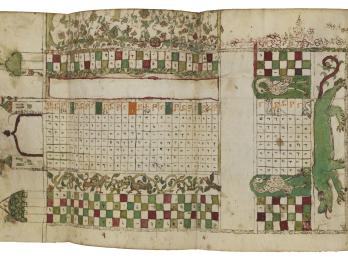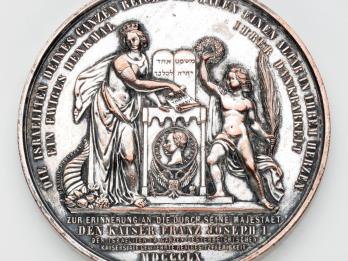On the Glory of the Eggplant
Unknown
16th Century
Various eggplant recipes have been passed down to us.
the first is one inherited from the late Morena:
you cut it into slices and throw them into the main dish
for that is how she was taught her by her in-law, Aunt Lena.
The second, if you will hear it, will delight you even more,
it’s one used by the wife of Elazar the Beadle
you empty out the insides and then fill them to capacity
and this dish was known as dolma [stuffed vegetables].
The third was made by Aunt Joya, the wife of Aksote:
she boiled them and cooked them and removed the tail-end,
with cheese and jarred oil she would fill them generously
and she named of this dish almodrote.1
The fourth was made by Yima, the wife of ḥayim Leche
Gavilan’s sister, and Merimeche’s niece:
after boiling them she crushed them into pieces
and, sprinkled with oil in the oven, the dish resembled gratinéed leek.
The fifth was made by Aunt Flor, Maranquina’s wife,
who saw it being made by a Greek woman dressed in Turkish attire:
she beat a lot of eggs in a bit of flour
adding fresh cheese and oil, she made it a soufflé.
The sixth was made by Estruga, Maimón’s wife,
a relative of Abudiente, Salomon’s sister-in-law:
she cut them into slices, fried them, and squeezed on them a lemon
for this is what she had seen Pavucha, Firmón’s wife, do. [ . . . ]
The eleventh was made by the lady from Sicily:
she fried them one at a time under a lamb chop,
and added a great amount of spices and saffron in abundance,
this is truly a fine dish, and very easy to make.
The twelfth was made by dear Esther, Yeḥiel’s wife,
David’s brother-in-law from Algiers:
she peeled them, preserved them, and added marmalade,
and she sent these to her friends, each in a small container. [ . . . ]
The eighteenth was made by Aunt Flor, Jacob Masa’s wife:
after beating eggs in a bowl, she rolled the eggplants in them;
then she fried them in a frying pan and covered them with sauce,
for this is how Moses Dasa’s mother-in-law had taught her.
The nineteenth was made by Micrí’s late wife
and the poor unfortunate Acńibuena, Perí’s wife,
Abraham Dri’s wife’s sister-in-law:
she made them into a little salad and cut them very finely like delicate crepes.
The twentieth was made by the excommunicated Naftalico
he cut them into fine slices and placed them under a fowl,
and he would sit down to eat them with a small radish beside his bowl,
for this is what he had observed at the house of the Cantor-ico.
The twenty-first was made by Aunt Rebecca-le, Calderon’s wife:
cut into strips like macaroni,
with onion and almond she made them a paste [torón]
and lightly fried with animal fat she called them baldarón [ . . . ]
The twenty-sixth was made by Pavona, Abudiente’s wife:
she emptied their flesh and removed their seeds;
afterwards she filled them with eggs, walnuts, and oil.
In order to complete this dish, she required a very fine piece of meat.
The twenty-seventh was made by Aunt Rachel, Isaac’s wife:
of the extra-large ones she chose seven or eight
then she mixed them with blanched almonds, and a formed them into a biscuit,
and, after adding plenty of spices and parsley, she fried and cooked the biscuit. [ . . . ]
The twenty-ninth was made by the in-law Bonafilla:
she sliced them placed them under a chicken
then she placed them in a brusalía casserole with garlic and pepper.
Put them in the oven you will savor a marvelous dish.
The thirtieth one was made by Nahma, David Prasa’s wife;
she grated them with a grater, as if she were grating pumpkin,
then she cut an onion into small pieces like home-made noodles
and put them in the oven before the embers started to burn. [ . . . ]
The thirty-second was made by Bathsheba, Pinḥas’s wife:
she made them into biscuits by adding fresh eggs and a bit of pure white flour
then she made them like esfongos2 and called them sulḥás
for that is how she was taught by Rosa, Meyuḥás’ wife.
The thirty-third was made by Sarah, the macaroni seller:
she emptied them out and left the bases
and filled them from the top and covered them with little caps,
and she added some very well-fried onion and a couple of cloves.
The thirty-fourth was made by ḥarifula, Maquedo’s wife,
and also by Zńinbulica, Ḥakham Toledo’s daughter:
one by one, she dug them out with her finger,
then she filled them generously and brazenly with cheese and eggs.
The thirty-fifth was made by Aunt Infanta, Farmela’s wife:
she placed them in a casserole dish with grated onions,
along with a brisket dusted with cinnamon
and she roasted them well in the oven by the light of a candle.
I urge you to try these recipes you have heard; sit down to eat them with a little radish by your plate,
make a good dried bean salad with pepper and parsley,
and after every few mouthfuls, take a little sip of your wine,
for thus it is recommended both for the poor and the rich alike.
Translated by .
David
Herman
Notes
[Almodrote is a dish of baked, chopped eggplant as well as paste of aged cheese and garlic. Here it is both.—Trans.]
[Esfongos is a Sephardic dish made of baked spinach topped with a mixture of cheese and eggs. Later, mashed potatoes were added to the egg mixture.—Trans.]
Credits
Author Unknown, “On the Glory of the Eggplant,” (Song, 16th century, Ladino). Published as: “Los Guisados de Los Berenjenas,” in Coplas Sefardíes: Primera Selección by Elena Romero (Cordoba: Ediciones El Almendro, 1988), 159–65.
Published in: The Posen Library of Jewish Culture and Civilization, vol. 5.




